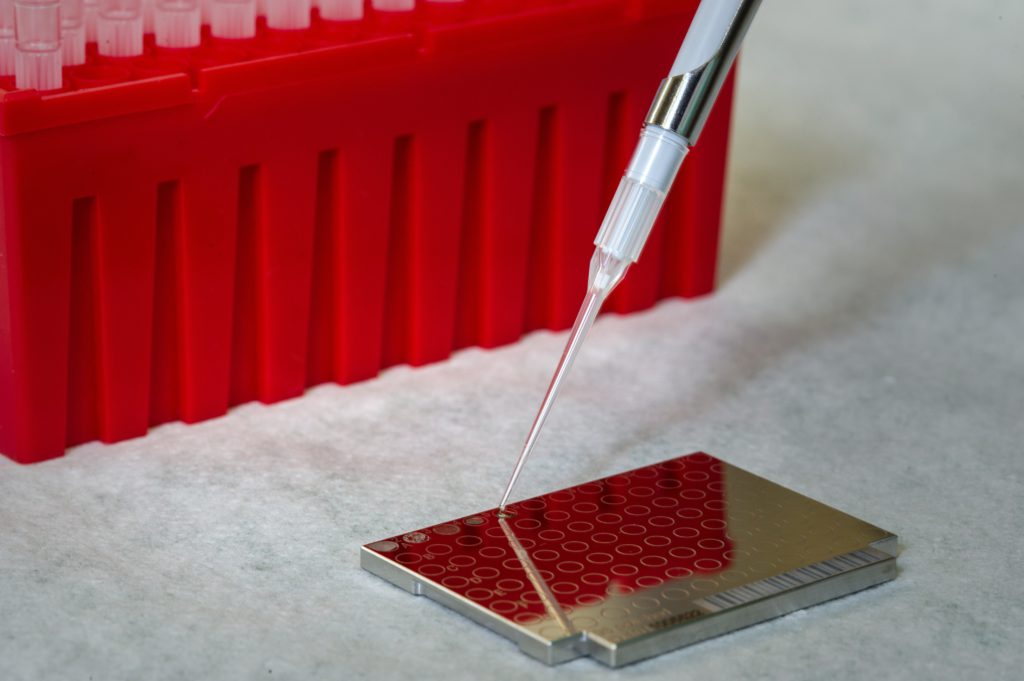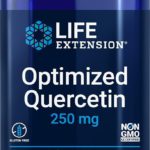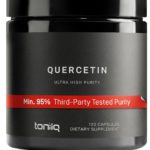You’re about to discover the potential of quercetin as an effective solution against bacterial infections. With its natural properties, this product has gained attention for its potential to serve as a natural antibiotic. Get ready to explore the wonders of quercetin and its ability to combat harmful bacteria, providing you with a natural and alternative approach to fighting infections.
Overview of Quercetin
What is quercetin?
Quercetin is a plant pigment and flavonoid compound that belongs to the group of polyphenols. It is widely found in various fruits, vegetables, and grains, giving them their vibrant colors. Quercetin is known for its antioxidant and anti-inflammatory properties, making it a popular dietary supplement.
Natural sources of quercetin
Quercetin can be found in a variety of plant-based foods such as apples, berries, citrus fruits, onions, broccoli, kale, and red wine. It is also present in certain herbs and spices like parsley, capers, and dill. Incorporating these sources into your diet can help increase your intake of quercetin.
Properties and benefits of quercetin
Quercetin exhibits numerous beneficial properties, including antioxidant, anti-inflammatory, antimicrobial, and anticancer effects. It has been shown to scavenge free radicals, reduce inflammation, and inhibit the growth of cancer cells. Additionally, quercetin has been studied for its potential to support cardiovascular health, regulate blood sugar levels, and enhance immune function.
Mechanisms of action
Quercetin exerts its effects through various mechanisms. As an antioxidant, it helps neutralize harmful free radicals and protect cells from oxidative damage. It also modulates various signaling pathways involved in inflammation, which contributes to its anti-inflammatory properties. Quercetin has been found to inhibit the growth and spread of cancer cells, and it may also help regulate gene expression related to cellular functions.
Understanding Bacterial Infections
Common types of bacterial infections
Bacterial infections can affect various parts of the body, causing a range of illnesses. Common types of bacterial infections include urinary tract infections (UTIs), skin infections, respiratory infections, gastrointestinal infections, and infections of the blood. Each of these infections is caused by different bacteria and may present with specific symptoms.
Symptoms and complications
Symptoms of bacterial infections can vary depending on the affected area and type of infection. Common symptoms may include fever, pain, redness, swelling, discharge, difficulty breathing, diarrhea, and fatigue. If left untreated, bacterial infections can lead to complications such as abscess formation, sepsis, organ damage, and even death in severe cases.
Conventional treatments for bacterial infections
Traditionally, bacterial infections have been treated with antibiotics, which are medications that target and kill bacteria. Depending on the type and severity of the infection, different classes of antibiotics may be used. However, the overuse and misuse of antibiotics have led to the emergence of antibiotic resistance, making bacterial infections more challenging to treat.
Emergence of antibiotic resistance
Antibiotic resistance occurs when bacteria adapt and become resistant to the effects of antibiotics. This can happen through genetic mutations or the acquisition of resistance genes from other bacteria. The misuse of antibiotics, such as not completing a full course or using antibiotics for viral infections, contributes to the development of antibiotic-resistant bacteria. This global health concern highlights the need for exploring alternative approaches in the fight against bacterial infections.

Exploring Quercetin’s Role
Antibacterial properties of quercetin
Quercetin has been extensively studied for its antibacterial properties. It has shown inhibitory effects against a wide range of bacteria, including both Gram-positive and Gram-negative species. Quercetin can disrupt bacterial cell membranes, interfere with bacterial growth, and inhibit the production of virulence factors, which are molecules that contribute to bacterial pathogenicity. These properties make quercetin a promising natural compound to combat bacterial infections.
Quercetin as an alternative to antibiotics
Given the increasing concerns regarding antibiotic resistance, researchers have turned to natural compounds like quercetin as potential alternatives to traditional antibiotics. Quercetin’s antibacterial properties, combined with its low toxicity and wide availability in plant-based foods, make it an attractive candidate for further exploration. While more research is required, quercetin holds promise as a potential adjunct or alternative therapy for bacterial infections.
Quercetin’s impact on bacterial growth
Studies have shown that quercetin can inhibit bacterial growth by interfering with essential cellular processes. It disrupts the integrity of bacterial cell membranes, leading to leakage of cellular contents and eventual cell death. Quercetin also inhibits key enzymes involved in bacterial metabolism and replication. Furthermore, it has been found to modulate the expression of bacterial genes, influencing their ability to survive and cause infection.
Research Studies on Quercetin’s Effectiveness
In vitro studies
In vitro studies involving isolated bacterial cells or cultures have provided valuable insights into quercetin’s antibacterial effectiveness. These experiments demonstrate the ability of quercetin to inhibit bacterial growth, disrupt biofilm formation, and attenuate virulence factors. However, it is important to note that in vitro studies may not fully represent the complex dynamics of bacterial infections within the human body.
In vivo studies
Animal studies have further supported the potential effectiveness of quercetin against bacterial infections. These studies involve infecting animals with specific bacteria and assessing the impact of quercetin on infection severity, bacterial load, and overall health outcomes. While these findings are promising, additional research is needed to determine the optimal dosage, treatment duration, and potential side effects of quercetin in vivo.
Comparison with traditional antibiotics
Several studies have compared the antibacterial activity of quercetin with that of traditional antibiotics. In some cases, quercetin has demonstrated similar or even superior effectiveness against certain bacterial strains. These findings provide further evidence for the potential of quercetin as an alternative or adjunct therapy to combat bacterial infections. However, more extensive clinical trials are required to fully evaluate quercetin’s efficacy and safety in comparison to standard antibiotic treatments.

Specific Bacterial Infections and Quercetin
Quercetin’s effect on Staphylococcus aureus
Staphylococcus aureus is a common bacterium that can cause a range of infections, including skin infections, pneumonia, and bloodstream infections. Studies have shown that quercetin can inhibit the growth of Staphylococcus aureus and reduce the production of toxins that contribute to its virulence. Furthermore, quercetin has been found to enhance the antimicrobial activity of certain antibiotics against this bacterium, potentially overcoming antibiotic resistance.
Quercetin’s effect on Escherichia coli
Escherichia coli (E. coli) is a type of bacteria that normally resides in the human intestines but can cause infections in other parts of the body. Research suggests that quercetin can inhibit the growth of E. coli and reduce its ability to form biofilms, which are communities of bacteria that protect against antibiotics. Quercetin has also been found to enhance the effectiveness of antibiotics against E. coli, offering a potential strategy to combat antibiotic-resistant strains.
Quercetin’s effect on Helicobacter pylori
Helicobacter pylori (H. pylori) is a bacterium known to colonize the stomach and cause gastritis, peptic ulcers, and even stomach cancer. Studies have demonstrated that quercetin can inhibit the growth of H. pylori and prevent the attachment of the bacterium to stomach lining cells. This suggests that quercetin may have a role in preventing or managing H. pylori infections, although further research is needed.
Quercetin’s effect on Streptococcus pneumoniae
Streptococcus pneumoniae (S. pneumoniae) is a major cause of pneumonia, sinus infections, and meningitis. Research has shown that quercetin possesses antibacterial activity against S. pneumoniae and can inhibit its biofilm formation. Additionally, quercetin has been found to enhance the effectiveness of antibiotics against S. pneumoniae, which is particularly important in the context of increasing antibiotic resistance in these bacteria.
Potential Mechanisms of Quercetin’s Action
Interference with bacterial cell membranes
One mechanism through which quercetin exerts its antibacterial effects is by interfering with bacterial cell membranes. Quercetin can disrupt the lipid bilayer, leading to changes in membrane integrity and permeability. This disruption ultimately impairs the normal functioning of the bacteria and can result in cell death.
Inhibition of bacterial enzymes
Quercetin has been found to inhibit key enzymes in bacterial metabolic pathways and replication processes. By targeting these enzymes, quercetin interferes with the bacterial cell’s ability to produce essential molecules and generate energy. This disruption weakens the bacteria and reduces its ability to grow, survive, and cause infections.
Modulating bacterial gene expression
Research has shown that quercetin can modulate the expression of specific bacterial genes involved in virulence and resistance mechanisms. By regulating the expression of these genes, quercetin can influence the bacteria’s ability to cause disease and evade immune responses. This modulation of gene expression may contribute to the antibacterial effects of quercetin.
Effects on bacterial biofilms
Quercetin has demonstrated the ability to disrupt the formation and stability of bacterial biofilms, which are complex communities of bacteria encased in a protective matrix. Biofilms can contribute to chronic infections and antibiotic resistance. Quercetin’s interference with biofilms may enhance the effectiveness of antibiotics and prevent the formation of drug-resistant bacterial populations.

Combination Therapy and Synergistic Effects
Quercetin in combination with antibiotics
Combining quercetin with antibiotics has shown potential for enhanced efficacy against bacterial infections. Studies have demonstrated that quercetin can enhance the antimicrobial activity of various antibiotics, particularly against drug-resistant bacteria. This suggests that the use of quercetin as an adjunct therapy alongside conventional antibiotics may help overcome antibiotic resistance and improve treatment outcomes.
Quercetin in combination with other natural compounds
Quercetin’s synergistic effects have also been observed when combined with other natural compounds. For example, combining quercetin with curcumin, a compound found in turmeric, has shown increased antibacterial activity against certain bacterial strains. These synergistic combinations may offer novel treatment options for bacterial infections while potentially minimizing the development of antibiotic resistance.
Safety and Side Effects of Quercetin
Recommended dosage
Quercetin is generally regarded as safe when consumed in amounts typically found in food sources. However, for therapeutic purposes or supplementation, it is essential to follow recommended dosage guidelines. The dosages can vary depending on the specific health condition being targeted, individual factors, and the form of quercetin used. It is advisable to consult with a healthcare professional to determine the appropriate dosage for your specific needs.
Potential adverse effects
In most cases, quercetin is well-tolerated when consumed as part of a balanced diet. However, some individuals may experience mild side effects such as digestive issues, headaches, or allergic reactions. It is important to discontinue use and seek medical attention if any adverse reactions occur.
Interactions with medications
Quercetin may interact with certain medications, particularly those metabolized by specific enzymes in the liver. It can affect drug absorption, metabolism, and excretion, potentially altering drug levels and efficacy. If you are taking any medications, it is crucial to consult with a healthcare professional before incorporating dietary supplements containing quercetin.
Precautions and contraindications
Quercetin is generally safe for most individuals, but caution should be exercised in certain situations. Pregnant or breastfeeding women, individuals with specific medical conditions, or those taking medications for blood-thinning or immunosuppression should consult with a healthcare professional before using quercetin supplements. It is always best to seek personalized advice to ensure safe and appropriate use.
Future Perspectives and Research
Exploring quercetin derivatives
Researchers are exploring various derivatives of quercetin to potentially enhance its efficacy and stability. These derivatives may possess improved antibacterial properties, increased bioavailability, and reduced side effects. By modifying the structure of quercetin, scientists aim to develop compounds with enhanced therapeutic potential against bacterial infections.
Strategies to enhance quercetin’s efficacy
Further research is needed to identify strategies that can enhance the efficacy of quercetin against bacterial infections. This may involve identifying optimal dosages, developing targeted delivery methods, or combining quercetin with other natural compounds to achieve synergistic effects. By understanding the mechanisms underlying quercetin’s action, scientists can devise innovative approaches to maximize its antibacterial activity.
Clinical trials and further investigations
The potential of quercetin as an alternative therapy for bacterial infections necessitates rigorous clinical trials and further investigations. These studies can evaluate the safety, efficacy, and optimal treatment protocols for quercetin. Additionally, more extensive research is needed to understand the long-term effects, potential drug interactions, and the impact of quercetin on specific populations.
Conclusion
Quercetin, a natural compound found in various fruits, vegetables, and grains, holds promise as a potential adjunct or alternative therapy for bacterial infections. Its antibacterial properties, low toxicity, and ability to enhance the effectiveness of antibiotics make it an intriguing option in the era of antibiotic resistance. While research is still ongoing, quercetin’s mechanisms of action and its impact on specific bacterial infections provide a solid foundation for further exploration. As we continue to investigate the potential benefits of quercetin, it is important to consult with healthcare professionals and adhere to recommended guidelines for safe and effective use.






